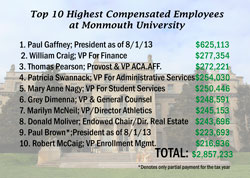Monmouth University documented an overall revenue of $200,430,546 on a return of organization exempt from income tax form 990 from the dates of July 1, 2013 through June 30, 2014. The document, which is public information, and the most recent return available to The Outlook, contains information regarding the financial breakdown of the university’s spending, including salary expenses, revenue of tuition and fees, and the total expenses of the university.
With over 200 million dollars in revenue and a recent increase of 4.25 percent in tuition for the 2015-2016 school year, some students have questioned what facets of the University received the additional tuition revenue. However, in the past three years, the University has made improvements to the campus with three new buildings, including academic buildings Rechnitz Hall and Pozycki Hall, as well as a residential building, Hesse Hall.
While an adequate learning environment is necessary for a proper education, some would say professors and adjuncts play the largest role in a student’s education. Monmouth University, a school that has presented itself as a “teaching university” versus a “research university,” (although faculty do conduct research) claims to pay its faculty comparatively with those of other higher education institutions in the area. The salaries of these professors, as reported in The Chronicle of Higher Education, as well as the American Association of University Professors (AAUP), find that this is not always the case.
According to the Form 990, a total of $100,150,588 in expenses is due to “salaries, other compensation, employee benefits” spread across the 3,276 “total number of individuals employed in calendar year 2013,” as documented on the tax return. In more cases than not, an average student spends more of their time with professors and adjuncts rather than any other employee of the university, however, not one traditional professor is receiving compensation documented in the form 990 as a “key employee” or “highest compensated employee.” The form showcases 10 employees, mostly Vice Presidents of the University, generating a yearly salary between $216,936 and $625,113. In fact, the top three salaries at Monmouth University during the 2013-2014 tax year were paid to Paul Gaffney, President; William Craig, Vice President of Finance; and Thomas Pearson, Provost & Vice President.
Professors at the University, whether they are tenured, tenure track, instructors, lecturers, specialists, or adjuncts, in some cases are receiving some of the lowest salaries within the state of New Jersey. According to the Chronicle of Higher Education, a full professor at Monmouth University is typically compensated $104,533 per year, which is lower than at least two community colleges in the area such as Passaic County Community College, which pays full professors $107,995 per year.
Other institutions, which might be described as less competitive four year universities also pay full professors more than Monmouth, although these tend to be public schools rather than private. Among them are William Patterson University, which pays its full professors $112,545 and Kean University, which pays its full professors $107,991.
Associate Vice President for Marketing and Communications, Tara Peters, maintains, “…community colleges along with William Patterson and Kean, are public institutions supported by state funding. Monmouth receives little to no state funding to support its operations so it is really not a direct comparison.”
Dr. Michael Phillips-Anderson, Associate Professor of Communication and Treasurer of FAMCO, points out, “In terms of the comparison to community colleges, the issue is not the source of the funding. Community colleges receive state support while we rely on tuition dollars. Given the level of Monmouth’s tuition, we have a great deal more money per student than a community college does. The issue is what are the priorities of what Monmouth chooses to spend the money on, not where it comes from. If our average faculty salaries are lower than the community college, it does not appear that faculty are a priority of the University.”
However, Monmouth does pay its full professors $1,402 more than Rider University, an institution many would describe as a peer university. Yet, Rider does pay their associate and assistant professors roughly $6,471 and $8,489 more than Monmouth, respectively.
“I find it very interesting that Monmouth University pays its faculty less than community colleges and its peer private universities. Students pay so much money to attend Monmouth University and are never fully aware of where their tuition goes,” said Amanda Lisi, a junior education student. “It’s surprising that our professors are being paid less than professors at other institutions. The school should have enough money to pay the professors just as much as any other institution with the tuition as high as it is. Monmouth’s professors are very well educated and work just as hard as those at similar schools. Therefore, [faculty] should be paid at a competitive rate.”
In order to become a full professor, one must first be on tenure track, which takes approximately seven years to complete at Monmouth University. Which, if done successfully, would give the faculty member tenure, a promotion, and a raise to associate professor. From that point, most professors progress until retirement. Some, however, successfully pursue a “full” professorship, which would grant a promotion and another salary increase. In order to achieve this somewhat elite status, one would have to go through a lengthy evaluation process and display the highest academic achievements in their field. Other professional faculty lie within the subcategories of instructors and lecturers, and visiting or specialist professors. Many of these faculty members are also being paid substantially lower salaries than others in the field.
According to The Chronicle of Higher Education, William Patterson University instructors typically receive an annual salary of $57,353 per year in comparison where Monmouth University’s instructor salary averages $46,323. Seton Hall University, a private institution, pays their instructors an average of $64,647. Of the 18 universities/colleges that The Chronicle of Higher Education reported instructor salaries on, Monmouth University was ranked last. With regard to lecturer compensation, Monmouth fared somewhat better, ranking 5th lowest of 11 schools in the survey (at $54,720).
“A salary-only comparison,” Peters said, “does not take into account other relevant factors. For example, there are other New Jersey colleges and universities that pay higher salaries but do not offer a comparable benefit package for spouses/domestic partners and family members like Monmouth does.”
Phillips-Anderson believes, “Faculty see that they are paying more for healthcare and receiving salary increases that are not keeping up with the cost of living. Offering competitive salaries helps the university to attract and attain the best faculty members.”
“The faculty salaries,” Robyn Salvo, Director of Human Resources, explains, “are negotiated fairly in a collective bargaining. So, that’s something that they would be talking to administration about during those collective bargaining periods to benchmark their salaries. I know that our administration is usually looking to make sure that our faculty are paid comparative salaries against the [other] institutions, especially if we’re looking to move our institution forward and be one of the top leaders, we need to attract top faculty. Which means we should be more towards one of the higher tier levels in benchmarking and looking at salary ranges.”
Based on The Chronicle of Higher Education statistics, one might conclude that in many instances, the University is not paying professors and faculty comparatively with other institutions. “Before hearing the findings, I would have assumed that the [faculty] compensation was fair. However, after seeing this I feel as if it is a little low for what goes into [a faculty member’s] position,” said senior class President and business student, Dylan Vargas. “I don’t think that it is too far off, and we are a private institution so I see where the numbers may vary in comparison.” If students can attend a community college with higher paid professors and lower tuition costs, one might consider whether they receive a better education at a two-year school than from Monmouth University’s four-year private institution.
“Professor salaries are not in tune with the level or heap of work required for student success. In essence, professors are the talent; the entire college experience rests off the performance of the professors, yet we are among the lowest compensated. It is, after all, classes, that students take to earn a college degree,” said an unnamed non-tenured professor at Monmouth University.
Phillips-Anderson adds, “Faculty compensation does not make up a majority of the University’s expenses or even a majority of overall compensation. Administration and non-faculty staff are important parts of our community, but classes are the major economic engine of the university. Faculty-student interaction is the heart of the university. Offering faculty competitive salaries that allow them to live in the area and provide for their families is a critical way that the university can recognize their contributions.”
According to The American Association of University Professors, looking beyond the state of New Jersey and considering the region, the average salary of a full professor at a Middle Atlantic masters institution is $100,753. Following this are associate professors, who collect an average of $78,179 per year. Next are assistant professors, earning an average of $63,941 per year. Following assistant professors are lecturers, earning $54,656 per year and instructors with an average salary of $49,827. Overall, Monmouth University tends to fall in line with these averages in a general sense. While instructors seem to be somewhat underpaid, associate and full professors are compensated above the regional average.
Peters points out, “…an institution that is not adding faculty to a rank and has little turnover is likely to have higher average salaries, while an institution that is expanding its faculty and brining in new faculty, possibly earlier in their careers, is likely to have somewhat lower average salaries in a rank. With the large number of faculty we have added in the last several years, we are being impacted by the second category. We have also had a number of senior faculty with higher salaries retire in recent years.”
“Retirements alone,” Phillips-Anderson said, “are not driving a change in the average salary in rank. We have been hiring mostly non-tenure faculty who are paid even less than their tenure-track colleagues. Starting salaries for nearly all full time faculty are not rising to keep up with the cost of living. Given that we have enrolled a record number of students, the money is there to invest in faculty.”
IMAGE MADE by Alyssa Tritschler &Amanda Glatz



